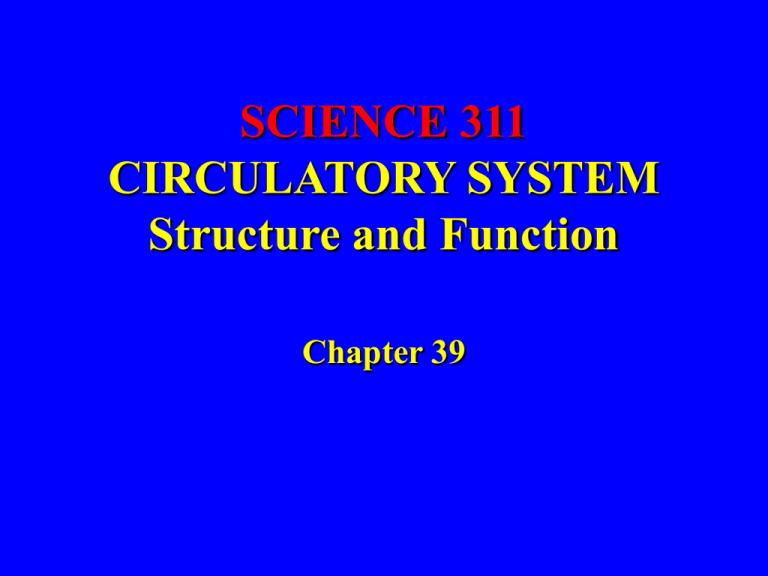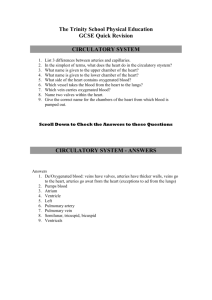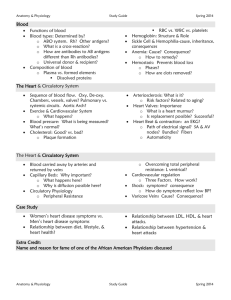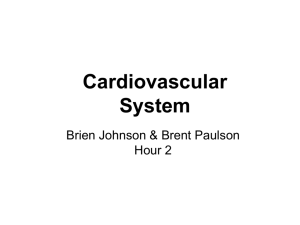
SCIENCE 311
CIRCULATORY SYSTEM
Structure and Function
Chapter 39
CIRCULATORY SYSTEMS
General Characteristics
• There are two basic types of circulatory
systems in the animal kingdom.
– Open system in which the blood spends a
portion of the time in the vessels of the
system and the other portion of the time in a
modified body cavity usually called a
hemocoel.
– Closed system in which the blood spends the
entire time it is circulating inside the vessels
of the system.
5/17/98
C.B.C. ALL RIGHTS RESERVED
©
2
Vertebrate Circulatory Systems - One Loop
In fishes, the heart consists of two chambers and blood flows in a single circuit.
The heart forces blood through the gills (where it is oxygenated), then through the
arteries to the capillary beds in the body tissues, and finally back to the heart.
5/17/98
C.B.C. ALL RIGHTS RESERVED
©
3
Vertebrate Circulatory Systems - Two Loop - Type A
In amphibians, the heart pumps blood through two partially separated circuits.
Some blood is pumped to the lungs, where it is oxygenated. It returns to the heart
and mixes with oxygen-poor blood still in the heart; then this partially oxygenated
mix is sent to the tissues.
5/17/98
C.B.C. ALL RIGHTS RESERVED
©
4
Vertebrate Circulatory Systems - Two Loop - Type B
In birds and mammals, a four-chambered heart pumps blood through two
different circuits. The heart’s right half pumps oxygen-poor, carbon dioxide-rich
blood to the lungs, where it is oxygenated and gives off carbon dioxide. Then, the
freshly oxygenated blood flows into the heart’s left half; from here it is pumped to
the tissues to deliver oxygen and pick up carbon dioxide.
5/17/98
C.B.C. ALL RIGHTS RESERVED
©
5
Characteristics of Blood
Blood volume for average-size adult humans is about 6-to8 percent of body weight. That amounts to about 4 or 5
quarts. If a blood sample is placed in a test tube and kept
from clotting, it will separate into two components
• a straw-colored liquid (plasma) and
• a red-colored cellular portion (red blood cells, white
blood cells, and platelets).
5/17/98
C.B.C. ALL RIGHTS RESERVED
©
6
Components of Blood
Plasma normally accounts for 50-to-60 percent of total
blood volume, and is mostly water. It functions as
• a transport medium for blood cells and platelets, and
• as a solvent for a variety of molecules, including simple
sugars, oxygen, carbon dioxide, and plasma proteins.
5/17/98
C.B.C. ALL RIGHTS RESERVED
©
7
Components of Blood
Red blood cells (erythrocytes) transport oxygen and carry
away some carbon dioxide wastes.
• Their red color is due to the presence of hemoglobin, an iron-
containing protein pigment that binds oxygen.
White blood cells (leukocytes) function as part of the
body’s housekeeping and defense systems.
• Some engulf old, damaged, or dead cells and anything that is
chemically perceived as foreign to the body.
• Others target or destroy specific bacteria, viruses, and other
agents of disease.
5/17/98
C.B.C. ALL RIGHTS RESERVED
©
8
Components of Blood
The smallest components of the cellular portion of the
blood are the platelets.
• They are non-nucleated, membrane-bound fragments of large
cells called megakaryocytes. Substances released from platelets
initiate blood clotting.
The following graphics show these components of the
blood and explain how they develop.
5/17/98
C.B.C. ALL RIGHTS RESERVED
©
9
Components of Blood
Erythrocytes make up about 99% of the cells in the blood.
5/17/98
C.B.C. ALL RIGHTS RESERVED
©
10
Components of Blood
5/17/98
C.B.C. ALL RIGHTS RESERVED
©
11
Components of Blood
5/17/98
C.B.C. ALL RIGHTS RESERVED
©
12
Components of Blood
5/17/98
C.B.C. ALL RIGHTS RESERVED
©
13
Human Cardiovascular System
Play the Animation on your CD-ROM to show these mechanisms of
vascular circuitry.
5/17/98
C.B.C. ALL RIGHTS RESERVED
©
14
Human Cardiovascular System
The heart is located in the thoracic cavity between the lungs. It is
surrounded by a protective pericardium—a double-walled sac with
fluid between the two layers.
5/17/98
C.B.C. ALL RIGHTS RESERVED
©
15
Human Cardiovascular System
The human heart
5/17/98
C.B.C. ALL RIGHTS RESERVED
©
16
Human Cardiovascular System
Cardiac muscle cells are branched. Adjacent cell membranes meet in folded areas
called intercalated discs. These regions are densely packed with gap junctions
(pores).
5/17/98
C.B.C. ALL RIGHTS RESERVED
©
17
Human Cardiovascular System
Human heart: its chambers, vessels to and from heart, valves to direct one-way
flow of blood.
5/17/98
C.B.C. ALL RIGHTS RESERVED
©
18
Human Cardiovascular System
Heart Valves in action; arrows indicate the direction of blood flow.
5/17/98
C.B.C. ALL RIGHTS RESERVED
©
19
Human Cardiovascular System
Ventricles relax and
would draw blood back
from the arteries but this
backpressure forces
semilunar valves closed.
Simultaneously,
contraction of the atria
forces open
atrioventricular valves,
allowing blood to flow
from the atria into the
ventricles.
5/17/98
C.B.C. ALL RIGHTS RESERVED
©
20
Human Cardiovascular System
Pacemaker of the heart is a
spontaneously active mass of
modified muscle fibers in the
right atrium called the
sinoatrial (SA) node. The
signal is spread through the
atrioventricular (AV) node
and ventricular muscle.
Play the Animation on your CD-ROM to show these mechanism of
heart contraction
5/17/98
C.B.C. ALL RIGHTS RESERVED
©
21
Human Cardiovascular System
The cardiac cycle. During early diastole, all chambers are relaxed and the
ventricles begin filling with blood. At the end of diastole, the atria contract and the
ventricles are filled with blood. During systole, the ventricles contract, ejecting
blood from the heart.
5/17/98
C.B.C. ALL RIGHTS RESERVED
©
22
Human Cardiovascular System
Blood pressure is the fluid pressure exerted by heart contractions. It is usually
measured in the brachial artery and is written as systolic pressure over diastolic
pressure (normal is about 120/80). In vessels smaller than arteries, blood pressure
drops significantly.
5/17/98
C.B.C. ALL RIGHTS RESERVED
©
23
Human Cardiovascular System
Arteries have a large diameter and present low resistance to flow. Thus, they serve
as rapid transporters of oxygenated blood. Their thick, muscular, elastic wall
bulges as ventricular contraction forces a large volume of blood into them. Then
the wall recoils and forces the blood forward through the circuit while the heart is
relaxing.
5/17/98
C.B.C. ALL RIGHTS RESERVED
©
24
Human Cardiovascular System
Track a volume of blood through the systemic route and you find the
greatest pressure drop at arterioles, for these offer the greatest
resistance to blood flow.
5/17/98
C.B.C. ALL RIGHTS RESERVED
©
25
Human Cardiovascular System
By some estimates, the human body has between 10 billion and 40
billion capillaries. Most capillaries have a diameter so small that red
blood cells must flow through in single file.
Each capillary is a tube of endothelial cells a single layer thick.
5/17/98
C.B.C. ALL RIGHTS RESERVED
©
26
Human Cardiovascular System
Veins are large-diameter, low-resistance transport tubes to the heart.
Some veins (mainly in the limbs) have valves to keep blood from
flowing backward in response to gravity. If the valves are damaged,
blood pools in "varicose veins.
5/17/98
C.B.C. ALL RIGHTS RESERVED
©
27
Human Cardiovascular System
Arteries can be partially obstructed by atherosclerotic plaques. Accumulation of
cholesterol in plaques is related to the concentration of cholesterol-carrying
lipoproteins. Your body needs some cholesterol—it is one of the major components
of cell membranes. An excess of cholesterol is what causes problems.
5/17/98
C.B.C. ALL RIGHTS RESERVED
©
28
Human Lymphatic System
A portion of the lymphatic system
called the lymph vascular system
consists of many tubes that collect
and transport water and solutes
from the interstitial fluid to the
circulatory system.
The lymph vascular system starts
at capillary beds, where fluid
enters the lymph capillaries. The
capillaries have no obvious
entrance; water and solutes move
into their tips at flaplike "valves."
5/17/98
C.B.C. ALL RIGHTS RESERVED
©
29
Human Lymphatic System
Valve in a lymph duct.
5/17/98
C.B.C. ALL RIGHTS RESERVED
©
30









